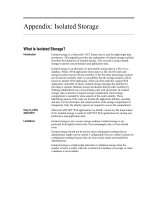Tài liệu Hibernate Tutorial 07 docx
Bạn đang xem bản rút gọn của tài liệu. Xem và tải ngay bản đầy đủ của tài liệu tại đây (25.1 KB, 8 trang )
Page 1 of 8
Hibernate Tutorial 07 Component Mapping
By Gary Mak
September 2006
1. Using a component
In our online bookshop application, a customer can place an order for purchasing some books. Our
staff will process his order and deliver the books to him. The customer can specify different
recipients and contact details for different day periods (weekdays and holidays). First, we add a new
persistent class Order to our application.
public class Order {
private Long id;
private Book book;
private Customer customer;
private String weekdayRecipient;
private String weekdayPhone;
private String weekdayAddress;
private String holidayRecipient;
private String holidayPhone;
private String holidayAddress;
// Getters and Setters
}
Then we create a mapping definition for this persistent class. We just map the properties of this
class as usual.
<hibernate-mapping package="com.metaarchit.bookshop">
<class name="Order" table="BOOK_ORDER">
<id name="id" type="long" column="ID">
<generator class="native" />
</id>
...
<property name="weekdayRecipient" type="string" column="WEEKDAY_RECIPIENT" />
<property name="weekdayPhone" type="string" column="WEEKDAY_PHONE" />
<property name="weekdayAddress" type="string" column="WEEKDAY_ADDRESS" />
<property name="holidayRecipient" type="string" column="HOLIDAY_RECIPIENT" />
<property name="holidayPhone" type="string" column="HOLIDAY_PHONE" />
<property name="holidayAddress" type="string" column="HOLIDAY_ADDRESS" />
</class>
</hibernate-mapping>
Page 2 of 8
One may feel that our Order class is not well designed, since the “recipient”, “phone”, “address”
properties have been duplicated two times for weekdays and holidays. From the object-oriented
perspective, we should create a class say Contact to encapsulate them.
public class Contact {
private String recipient;
private String phone;
private String address;
// Getters and Setters
}
public class Order {
...
private Contact weekdayContact;
private Contact holidayContact;
// Getters and Setters
}
Now the changes are done for Java. But how can we modify the Hibernate mapping definition to
reflect the changes? According to the techniques we have learned before, we can specify Contact as
a new persistent class and use a one-to-one association (the simplest way is to use a <many-to-one>
association with unique="true") to associate Order and Contact.
<hibernate-mapping package="com.metaarchit.bookshop">
<class name="Contact" table="CONTACT">
<id name="id" type="long" column="ID">
<generator class="native" />
</id>
<property name="recipient" type="string" column="RECIPIENT" />
<property name="phone" type="string" column="PHONE" />
<property name="address" type="string" column="ADDRESS" />
</class>
</hibernate-mapping>
<hibernate-mapping package="com.metaarchit.bookshop">
<class name="Order" table="BOOK_ORDER">
...
<many-to-one name="weekdayContact" class="Contact" column="CONTACT_ID"
unique="true" />
<many-to-one name="holidayContact" class="Contact" column="CONTACT_ID"
unique="true" />
</class>
</hibernate-mapping>
Page 3 of 8
In this case, modeling the Contact class as a standalone persistent class seems not suitable. This is
because it is meaningless once departed from an order. Its function is much on grouping some
values logically. It should not be a complete persistent object with object identifier. Hibernate is
providing a concept called “components” for mapping this kind of objects.
<hibernate-mapping package="com.metaarchit.bookshop">
<class name="Order" table="BOOK_ORDER">
...
<component name="weekdayContact" class="Contact">
<property name="recipient" type="string" column="WEEKDAY_RECIPIENT" />
<property name="phone" type="string" column="WEEKDAY_PHONE" />
<property name="address" type="string" column="WEEKDAY_ADDRESS" />
</component>
<component name="holidayContact" class="Contact">
<property name="recipient" type="string" column="HOLIDAY_RECIPIENT" />
<property name="phone" type="string" column="HOLIDAY_PHONE" />
<property name="address" type="string" column="HOLIDAY_ADDRESS" />
</component>
</class>
</hibernate-mapping>
There is no new persistent object introduced. All the columns mapped for these components are on
the same table as their parent object. Components do not have an identity, and exist only if their
parent does. They are most suitable for grouping several properties as a single object.
2. Nested components
Components can be even defined to be nested, i.e. components embedded within other components.
For example, we can define the phone property as another component and embed it into the contact
component.
public class Phone {
private String areaCode;
private String telNo;
// Getters and Setters
}
public class Contact {
private String phone;
private Phone phone;
// Getters and Setters
}
Page 4 of 8
<hibernate-mapping package="com.metaarchit.bookshop">
<class name="Order" table="BOOK_ORDER">
...
<component name="weekdayContact" class="Contact">
<property name="recipient" type="string" column="WEEKDAY_RECIPIENT" />
<property name="
phone" type="string" column="WEEKDAY_PHONE" />
<component name="phone" class="Phone">
<property name="areaCode" type="string" column="WEEKDAY_PHONE_AREA_CODE" />
<property name="telNo" type="string" column="WEEKDAY_PHONE_TEL_NO" />
</component>
<property name="address" type="string" column="WEEKDAY_ADDRESS" />
</component>
<component name="holidayContact" class="Contact">
...
</component>
</class>
</hibernate-mapping>
3. References in component
A component can have a reference to its parent object through a <parent> mapping.
public class Contact {
private Order order;
private String recipient;
private Phone phone;
private String address;
// Getters and Setters
}
<hibernate-mapping package="com.metaarchit.bookshop">
<class name="Order" table="BOOK_ORDER">
...
<component name="weekdayContact" class="Contact">
<parent name="order" />
<property name="recipient" type="string" column="WEEKDAY_RECIPIENT" />
<component name="phone" class="Phone">
<property name="areaCode" type="string" column="WEEKDAY_PHONE_AREA_CODE" />
<property name="telNo" type="string" column="WEEKDAY_PHONE_TEL_NO" />
</component>
<property name="address" type="string" column="WEEKDAY_ADDRESS" />
</component>
</class>
</hibernate-mapping>
Page 5 of 8
A component can be used to group not only normal properties, but also many-to-one and one-to-one
associations. Suppose we want to associate the address of an order to the address in our customer
database.
public class Contact {
private Order order;
private String recipient;
private Phone phone;
private String address;
private Address address;
// Getters and Setters
}
<hibernate-mapping package="com.metaarchit.bookshop">
<class name="Order" table="BOOK_ORDER">
...
<component name="weekdayContact" class="Contact">
...
<property name="address" type="string" column="WEEKDAY_ADDRESS" />
<many-to-one name="address" class="Address" column="WEEKDAY_ADDRESS_ID" />
</component>
</class>
</hibernate-mapping>
4. Collection of components
Suppose we need to support a more flexible contact mechanism for our book ordering. A customer
can specify several contact points for a book delivery as he may not sure which one is most suitable
for a specified time period. Our staff will try to contact these points one by one when they deliver
the books. We use a java.util.Set to hold all the contact points for an order.
public class Order {
...
private Contact weekdayContact;
private Contact holidayContact;
private Set contacts;
// Getters and Setters
}
To map many contact points for an order in Hibernate, we can use a collection of components. We
use <composite-element> to define the components in a collection. For simplicity, we first rollback
our Contact class to the original form.









